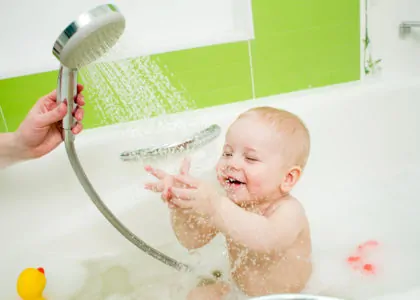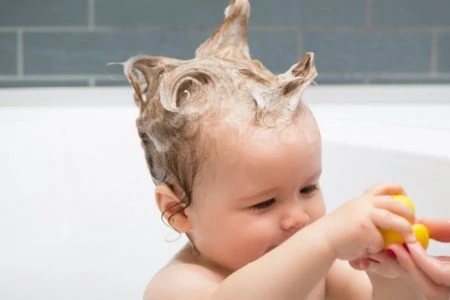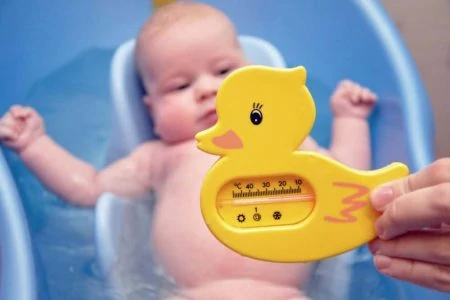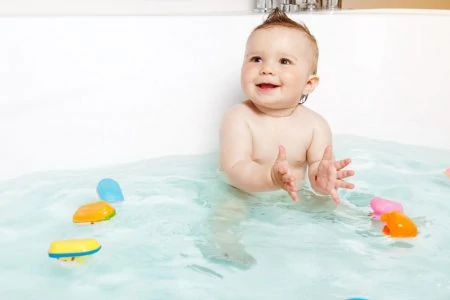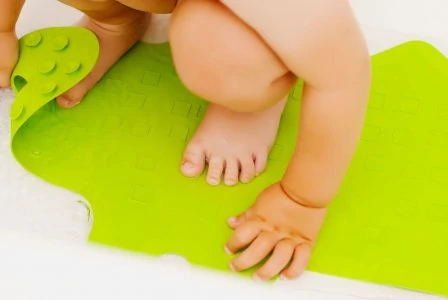Bathing and showering are the two main ways we stay clean and relatively germ-free. For adults, our showering schedules vary. Some shower every other day, while for others, it’s a daily ritual. So, when it comes to children, parents wonder how often to bathe their baby or toddler.
The answer will vary, depending on the parent. Some will tell you to incorporate it into your child’s bedtime routine, while others advise you to bathe them less. We’ll look at the facts and consider the topic from a medical viewpoint to help make some sense of it.
Key Takeaways
- Bathe babies three times a week during their first year and toddlers as needed, focusing on hand-washing after messy activities.
- Daily baths can strip essential oils from the hair and dry out the skin, potentially worsening conditions like eczema.
- Exposure to some germs can help strengthen a child’s immune system and protect against asthma or allergies.
- For newborns, wait until the umbilical cord has fallen off before giving a bath, and use sponge baths in the meantime.
How Often to Bathe Your Baby or Toddler
How often you bathe your baby or toddler is entirely up to you. Many children sleep well following a bath, which is why many parents include it in the bedtime routine. However, bathing too often can bring more harm than good.
Generally, once the umbilical cord stump has fallen off, I recommend bathing infants no more frequently than every 2 days. If you have a baby boy who was circumcised, it is best to wait until the area has healed before bathing him (1). Exceptions to less frequent bathing are if your baby passes a very large stool (the kind that leaks out of the diaper), has diarrhea, or has been involved in family activities that are “messier” than usual (i.e., going to the beach).
Editor's Note:
Dr. Leah Alexander, MD, FAAPBabies
Small babies don’t require daily baths. Three times a week should suffice during their first year (2). Even at birth, the recommendation for when to do the first bath has changed over the years. It has been found that delaying this bath until 24 hours after birth is more beneficial. This delay improves the likelihood of breastfeeding success and prevents hypothermia (3). For now, a good wipe-down following spit-ups and diaper changes is enough. Once your little one begins to crawl, you can increase bath times if you prefer.
If you worry about germs as your baby is crawling, you can wipe their hands whenever you get the chance. However, don’t stress about it — bacteria aren’t always harmful.
Toddlers
Once your baby becomes a toddler, you can increase their baths. The toddler phase, around 12 to 36 months of age, is a time of hands-on exploration. Your little one will investigate, attempt to self-feed, and dig in the dirt — or sometimes even the garbage can.
Such activities require proper sanitation, but you should still keep baths to a minimum. Instead, teach your toddler to wash their hands properly using soap, and remind them to do it following play.
Why Everyday Baths Aren’t Always Ideal
1. Germs are Good
If your main reason for bathing your baby or toddler is germs, then you may be pleased to learn that bacteria are not always the enemy.
Your little one is still developing — this includes their immune system. Exposure to germs can help strengthen your baby’s defenses against viruses and conditions like asthma or allergies (4).
One study showed that the youngest baby in a large family was less likely to develop asthma and allergies. They were exposed to germs and bacteria from infections passed around between the siblings earlier on (5).
Not every infection will benefit your baby, but being exposed to such contagions is the only way a baby’s body can learn to fight them.
2. Hair Issues
If you choose to bathe your toddler every day, hold the shampoo. Shampoos work to strip oils from the hair — such oils are what give the hair a lush and healthy look.
If adults go too long without shampooing, the oils trap dirt and odors. It’s not the same for babies and toddlers. On the contrary, by shampooing too often, you run the risk of drying out their hair (6). This is particularly true for coarse, curly hair.
It can be tricky with toddlers, as they always seem to get stuff in their hair, particularly girls. The best thing to do is to wash the hair as needed. Use a mild baby shampoo that won’t dry out the strands by frequent use.
During the first year of life, you may notice a crust or yellow flakes on your baby’s scalp. It can vary from just a few spots to a thick yellow, oily crust that covers most of the scalp and extends down the face and body. If you notice this, your baby has seborrhea or “cradle cap” (7). It is essentially an infant version of dandruff, like older kids and adults may experience. In this situation, daily hair washing with a cradle cap shampoo helps reduce the appearance of seborrhea and its associated itchiness.When the usual baby shampoos do not seem effective, I recommend using a basic dandruff shampoo every other day for one week, being very careful not to get into the eyes. Although using oil on the scalp to loosen the crust of flakes is recommended by some authorities, I find clinically that adding oil just worsens the condition.
Editor's Note:
Dr. Leah Alexander, MD, FAAP3. It’s Time-Consuming
If you have more than one child, bathing them daily requires effort. Parents don’t always look forward to nightly baths, nor is it always feasible.
You shouldn’t feel bad if you skip bath time because you’re feeling tired or don’t have time.
Baths are time-consuming, especially with children aged 4 years and under. At this age, it’s essential to supervise your child in the tub is vital. It only takes a few inches of water for a child to drown if they roll over or get stuck (8).
It is often helpful and safer to use a smaller bath basin for infant bathing (9). Even if you use bath rings or seats, it’s not a guarantee for safety. Such items are there for support, not to prevent drowning. So, if you don’t have time to give your full attention, it’s best to wait.
4. Dry Skin
Bathing your baby or toddler too frequently can dry out the skin significantly, worsening conditions like eczema (10). In practice, I see quite a bit of infant eczema, and it can be a challenging problem for parents. Keeping the skin moisturized is essential for controlling eczema flares, so bathing less frequently can help.
It’s a challenging balance to figure out what’s best, seeing that not bathing enough can also aggravate eczema and other skin issues (11). Remember, bathing in water isn’t the most significant irritating issue — it’s the soap and cleansing products we tend to use.
Leaving your little one in a bath full of soap will draw moisture from their skin, leaving it dry and exposed.
Sensitive or eczema-prone skin will worsen with frequent washings, especially if you use cleansing products. If your child has either of these conditions, leave bath time to every two to three days.
Clinically, my top recommendation is a dye-free, fragrance-free moisturizing bar (I like Dove) instead of soap or baby wash. Over the years, I have found this to be less drying of infant skin.
Editor's Note:
Dr. Leah Alexander, MD, FAAPIf you choose to bathe your baby every night before bed, keep it short. The water should be lukewarm, and you should only use cleansers or soap right at the end to minimize the exposure.
Following the bath, pat — don’t rub — your baby dry with a towel. Then apply a child-friendly moisturizing lotion or another cream recommended by your pediatrician. If you have noticed a sensitivity to oat cereal after introducing it as a first food, it is best to avoid any skin products containing colloidal oatmeal. Such products will cause or worsen your baby’s eczema.
To combat dry skin, apply the cream or lotion while the skin is still a little damp. Then pat gently again with a towel.
Newborn Baths
